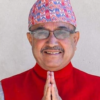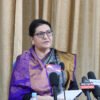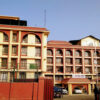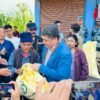Kathmandu, April 1: Gehendra Kayastha is the 9th generation of his family migrated from Bhaktapur to Bandipur, a hilltop town in Tanahu district. Currently only two members at home- Kayastha and his spouse- they are running a homestay and a mom-and-pop grocery.
Their children left home for job and foreign study. There is no difficulty to manage livelihood for this couple, but they love hospitality and want to welcome more and more tourists in the ancient town.
“I enjoy preparing home-cooked family foods and serving the visitors. We- husband and wife- are over 50 in age but fascinated to hospitality after the revival of the town,” Kayastha explained.
He remembered those horrible days when the beautiful town, Bandipur, a bustling trade hub for long, was deserted after the district headquarters of Tanahu was shifted from there to Damauli, down to the Prithvi Highway. “Many people left this beautiful town, but my family did not. Those were difficult days after the relocation of district headquarters. Trades declined sharply; neighbourhood turned desolate with dwindling public mobility,” he recounted, expressing deep gratitude to those who contributed much to revive the old cultural town, Bandipur, thereby making it a bustling settlement again.
As Bandipur was ceased to be a trade centre after shifting the Tahanu district’s headquarters, one of the measures to revive Bandipur’s aura was ‘homestay’ scheme. It was launched in 2008.
However, Kayastha family began homestay only since 2018. “I was a transport entrepreneur before. But, since 2018, I began homestay welcoming domestic tourists, who relish organic cuisine which I prepare at home,” he shared.
During the visit this scribe had last week, another Raju Pradhan from the same town said he belonged to the 6thgeneration of migrant from Bhaktpur. He, however, had given his home in rent to run a hotel. He visits the hometown frequently. Living in Chitwan and Kathmandu as well, Pradhan expressed worry whether the ancient town will be able to retain its cultural vivacity for long. His special concern is regarding the migration of young generation despite its revival of the town.
Pradhan also thanked some intellectuals like Mathura Prasad Shrestha and Chij Kumar Shrestha who worked hard to launch various projects to bring this Bandipur town to life again.
The Newari settlement which was a trade hub, especially for clothes from India to Tibet, since the 19th century, lost it charm, especially after 1968 when Tanahu shifted its district headquarters to Damauli. Populated largely by the Newari people migrated from Bhaktpur, it was earlier the Magar settlement. But, the relocation of the district headquarters was a severe blow to the trade here.
Many people migrated to Pokhara, Damauli, Chitwan, and even to Kathmandu after the transfer of headquarters. Some sold out their properties while some left their houses as they were. Then the old town turned desolate for long- nearly three decades.
However, the people who had migrated from Bandipur to Kathmandu could not remain indifferent to their birthplace.
In response to a question how the deserted Bandipur was revived, educationist Bikram Piya shared that the intellectuals from this place worked in coordination to revitalize this town, thereby paving way to usher in the present must-visit tourist destination of Nepal.
Piya, also the Chief of Bandipur Campus, prides on the revival initiatives launched by then minister Dr Mathura Prasad Shrestha (late), Chij Kumar Shrestha (educationist), Shanta Bahadur Shrestha (senior tourism entrepreneur), Dr Madan Kumar Piya (senior oncologist), senior advocate Kushum Shrestha (late) and Jivan Kumar Shrestha (bureaucrat). The establishment of Bandipur Development Committee in 1992 was a landmark step of these intellectuals to reawaken this town, he added. This initiative brought good road, hospital, drinking water facility and higher education.
Since then, various programmes were enforced to restore the Bandipur aura and make it a tourist destination. The Bandipur Eco-Cultural Tourism Project was implemented in 2005 to 2006. The activities under this project had tremendous role in tourism boost and keeping intact the traditional features in Bandipur.
Trade hub to tourism hub
Importantly, after the revitalization, the town turned a tourism hub, unlike the trade hub. In response to why it lost trade, Piya’s argued it was left to the south of the Prithvi Highway, causing downfall in business activities.
“The Bandipur trade hub linked to Lamjung, Kaski and Gorkha to Tibet. The clothes were brought via Thori, Chitwan from India to Bandipur then,” he informed.
Moreover, Piya recounts those tough time of persuading locals to launch new initiatives like keeping intact traditional and cultural mosaic in the town. “After the project, Bandipur bazaar introduced ‘no vehicle entry’. It was really difficult to convince the locals to ban vehicles in the main bazaar, but later the locals gradually realized the value when tourists- domestic and foreign loved the old footpath, carved wood in gate and building.” The use of modern construction materials is discouraged to save originality of the town.
Interestingly, Piya shared in the beginning the Newari traders of Bandipur had to speak Gurung language, while at present they should be able to speak English to welcome foreign tourists.
Establishment of an English medium school also counts much to the revitalization of Bandipur in his view.
The Bandipur revival is envied and other settlements also want to follow suit. “I was invited by Bhimphedi rural municipality of Makwanpur district to give a lecture on how Bandipur was revived and what could be replicated there for revival,’ shared Piya.
Located at the elevation of 1,030 meter above sea level, Bandipur is further decorated with scenic views in vicinity: a hill up it is famous for sighting sun rise. Tourists could be seen enjoying morning walk up to the Mini Great Wall.
A tourist found atop the hill near Thani Mai Temple with her Nepali guide in the morning, Ella Rowdon, talked to the scribe, “I love walking in village, mountain and hills. I want to come here again.”
She shared that her friend from Chitwan suggested the Bandipur visit. In her observation, Nepali people are kind and generous. “Nature is enchanting here. I stay here for three days,” he added.
Similarly, another domestic tourist from Pokhara, Jamuna Malla, said she had gone there with the management of a cooperative. “Although it is my first time, I strongly suggest others to visit Bandipur once,” she told this scribe.
The Bandipur rural municipality is currently observing the Bandipur Visit Year 2025 in a bid to protect and promote tradition and culture and foster economic activities.
The Siddha Gupha, Khadga Devi Temple, Gurungche Hill, Mukundeshwori, Football Ground are the places around the Bandipur settlement the tourists love to visit.
The time after Dashain and Tihar festivals is the peak season of tourist arrival in this hilltop town.
In addition to the homestay facility, the availability of low to medium cost hotels in a number of over six dozens also encourages the visitors to prolong stay.





